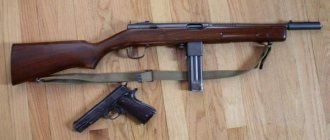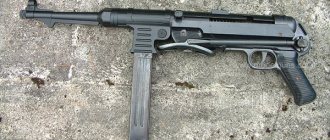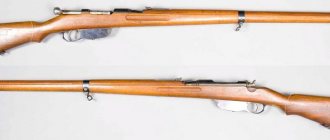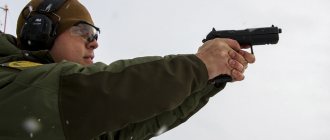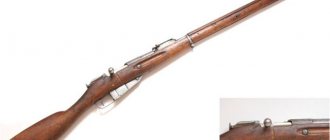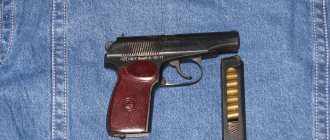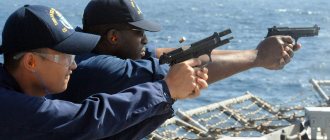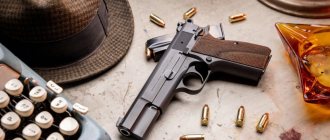PM - this abbreviation is familiar, perhaps, to all men, without exaggeration, on half the globe
Today we will tell you about one of the best and famous pistols of the 20th century. The Makarov pistol has been in service for almost 70 years. This legendary weapon (as it is called, “Kalashnikov” in the world of pistols) has saved the lives of law enforcement officers and the military more than once during its service. It is overgrown with a considerable number of legends and rumors. We will try to tell you the ongoing history of the Makarov pistol as objectively as possible.
Creation
The pistol, designed in 1948 by Nikolai Makarov, immediately fell into the harsh conditions of competitive selection. Along with Makarov, the best Soviet gunsmiths presented their concepts for a new pistol, created based on the results of the just ended Great Patriotic War. Among them were F.V. Tokarev, S.G. Simonov, S.A. Korovin, I.Ya. Stechkin, A.A. Klimov and others. Agree, it is difficult to win among such “mastodons” of the arms business.
PM scheme
Source: pinterest.ru
The new pistol had to meet the stringent requirements for the personal weapons of Soviet officers: compactness, ergonomics, high reliability, manufacturability, ease of operation, and most importantly, a new caliber for the USSR - 7.65 or 9 millimeters.
Our no less famous TT-33 pistol, due to its design and, most importantly, the caliber of the cartridge, which often did not give the desired stopping effect, needed to be replaced. One of the first myths around PM is connected with this. Many people think that Makarov “stole” the design of the German Walther PP, which had been in production since the late 20s. But this is not so, Makarov simply used the same scheme - free shutter recoil. At the same time, the PM turned out to be much simpler and structurally more reliable than the Walter: the PM consisted of only 25 parts. Let's give the floor to the pistol designer himself:
“Suffice it to say that at that time I worked every day, practically without days off, from eight o’clock in the morning until two or three o’clock in the morning, as a result of which I modified and shot samples two or even three times larger than mine rivals, which, of course, made it possible to perfect reliability and survivability.”
PM in disassembled state
Source: pinterest.ru
Makarov pistol PM / PMM / IZH-71 (USSR/Russia)
Experimental pistol of the Makarov system, 1947
Pistol of the Makarov PM system, produced in 1949
Pistol of the Makarov PM system, produced in 1971, left view
Pistol of the Makarov PM system, produced in 1971, right view
Pistol of the Makarov PM system, modern premium version
Izh 70-17AS pistol, export version for the American market chambered for 9x17 cartridge, produced in the early 1990s.
Pistol Izh 71X caliber 9×17 (.380ACP), export commercial version of the PMM pistol with a 12-round magazine
Modernized Makarov-Shigapov pistol, PMM
Experimental pistol TKB-023 with a polymer frame, developed in Tula in the early 1960s based on the Makarov pistol photo: Instrument Design Bureau
Sectional design of the Makarov PM pistol
Caliber
, 9×18mm;
9×18 PMM Length
: 161 mm (165 mm PMM)
Weight without cartridges
: 730 g (760 g PMM)
Barrel length
: 94 mm
Magazine capacity:
8 rounds (12 rounds PMM)
The Makarov system pistol was created in response to the requirement of the Soviet Army to develop a new pistol for self-defense of officers, more compact and safer to handle than the Tokarev TT pistol, but at the same time having a greater stopping effect of the bullet. The requirements stipulated a compact pistol with a self-cocking trigger mechanism and a blowback bolt. Initially, a new 9mm caliber cartridge was developed, which had a sleeve length of 18 mm and, in terms of power, represented the reasonable maximum that can be used in a blowback pistol. This development was based on pre-war German work in the same direction, which led to the creation by GECO of the 9x18mm Ultra cartridge. It should be noted that despite the identical designations, the PM pistol cartridge is not interchangeable with the German one, since it has a larger bullet diameter. Two pistols were then created for the new cartridge and put into service in 1951: the Makarov pistol - the personal self-defense weapon of officers, and a more powerful pistol for the self-defense of privates, gun crews and tank crews - the Stechkin APS automatic pistol.
Until the early 1990s, the PM remained the main self-defense weapon for military personnel, as well as the main weapon for the police. However, the changing situation in the world has led to the need to adopt more powerful and effective personal weapons, the development of which began as part of the Rook competition. For this competition, a reinforced version of the 9x18mm PMM cartridge was developed, which had a lighter bullet and an increased powder charge, accelerating the new bullet to 430 m/s instead of the usual 315 m/s. In addition, on the basis of the PM, a PMM pistol was created, adapted for new cartridges and having a magazine capacity increased to 12 rounds, for which it was necessary to increase the width of the pistol handle. In addition, the PMM has acquired slightly improved handle cheeks. However, in 2000 it was announced that the “Rook” competition was won by Yarygin’s pistol, created at the Izhevsk Mechanical Plant under the symbol MP-443. Thus, the PM will be gradually removed from service with the Armed Forces, the Ministry of Internal Affairs and other law enforcement agencies of Russia, being replaced by PYa and other modern pistols, however, due to the difficult financial condition of the country as a whole, this process will not be quick and will take more than one year. It should be noted that the PMM pistol went into mass production in a version chambered for the standard 9x18 cartridge, since there was a real danger of using 9x18 PMM cartridges in old pistols of the Makarov and Stechkin system, which could lead to accelerated wear and even destruction of these pistols.
On the basis of the PM at the Izhevsk Mechanical Plant, the main manufacturer of the Makarov pistol, a number of modifications were created, including the IZH-79 gas pistol, the IZH-71 service pistol chambered for 9x17mm Browning Short, the Baikal MP-442 export pistol of 9x18mm caliber and a number of others. In addition to the USSR and Russia, the PM was produced under license in Bulgaria, the German Democratic Republic and China. Poland, Hungary and Czechoslovakia produced their own models of pistols chambered for the same 9x18mm PM cartridge. During the production of the Makarov pistol in Izhevsk, a large amount of work was carried out to improve the manufacturability of its production. In addition, in the sixties, the Tula Design Bureau (now the Instrument Design Bureau) carried out work to lighten the pistol by developing a frame made of light alloys or plastic for it. The pistol with a plastic frame was tested in 1963-65 under the designation TKB-023, and showed generally good results. However, the military refused to adopt it, motivating their decision, among other things, by the fact that it was unknown. how plastic behaves during long-term (10-20 years) storage and operation.
The Makarov PM pistol was (and still is) one of the best representatives of pistols in the class of compact self-defense weapons. It is small in size, extremely reliable, easy to use and maintain. Its disadvantages, however, are common to any other pistol of the same size and class - short range and shooting accuracy, low bullet efficiency. In addition, the disadvantages specific to the PM in comparison with modern pistols of the same class are the rather significant mass of the weapon and the small magazine capacity.
The Makarov pistol is built on the basis of automatic blowback action. The pistol is made almost entirely of steel. The return spring is located around the fixed barrel. The trigger mechanism is double-action (self-cocking), with an open hammer. The safety is located on the left side of the bolt, and when turned on, it blocks the firing pin, then safely removes the hammer from cocking, after which it locks the sear and bolt. The first shot after turning off the safety can be fired either by self-cocking or by first cocking the hammer manually. The sights are open and non-adjustable. On a number of export modifications, an adjustable rear sight can be installed. The pistol is fed from detachable steel box magazines with a capacity of 8 rounds. PMM pistols were equipped with double-row magazines with a capacity of 12 rounds with the cartridges rearranged into one row at the outlet of the magazine. The magazine release latch is located at the bottom of the handle, behind the magazine window. The cheeks of the handle are plastic, brown or black, with fine corrugation, in the PMM version - with a shelf for the thumb.
destructive force
The main feature of the new pistol was a new caliber for the USSR. It is clear that foreign-made 9-mm pistols were well known to us, but then a cartridge-pistol shooting complex appeared. The new 9x18 PM cartridge has also become the source of various legends and myths.
Evolution of PM
Source: pinterest.ru
Modern “armchair experts” are confident that the PM, like its cartridge, is terribly weak and, in addition, inaccurate. Indeed, our pistol does not have the accuracy and destructive power of a sniper rifle. Nevertheless, it perfectly solves the tasks for which it was created, namely a compact and reliable self-defense weapon.
At a distance of 25 meters, the PM gives a dispersion of 75 millimeters, and from 15 meters, an experienced shooter can put all eight rounds of the magazine into the chest target, shooting from the hip, due to the straight pistol grip and comfortable ergonomics.
Silent option - PB
Source: pinterest.ru
Separately, it is necessary to say about the cartridge. If the usual 9x18 PM cartridge (57-N-181) is quite suitable for self-defense, but, according to many commentators, does not have the necessary destructive power, then in addition to it there is a huge range of cartridges for our pistol. Expansive ones give less ricochets, armor-piercing PBMs penetrate bulletproof vests quite well, etc. Therefore, we can reduce all talk about the “inadequacy” of something in our pistol to speculation and demagoguery. It fully meets the requirements of a self-defense weapon, and when using various specialized cartridges, it exceeds them.
Description of the pistol
The model is produced by the Izhevsk Mechanical Plant. The Makarov pistol was chosen as the prototype for the IZH-79-8. The basic design remains from this model. The self-cocking trigger and frame are made of weapon-grade steel. The shutter is lightweight and is thrown back by the charge pulse.
The barrel is thin and contains a bushing, which prevents the pistol from being converted to a live cartridge. The use of high-quality materials makes the model superior to many analogues in reliability. The pistol uses sonic and gas cartridges. The Izhevsk plant produces 2 modifications: for 7.6 mm and 8 mm ammunition.
Design
There are also significant differences in the trigger design, and the main advantage was the bolt stop lever added by Makarov. The PM pistol magazine and safety also received some changes. Combining the functions of parts in the design of the PM made it simpler, and the parts themselves were significantly smaller compared to the Walter PP. So, for example, the bolt stop in the design of a Makarov pistol has the function of a shell deflector, and the mainspring is also a sear spring, a cocking lever, and when the safety is put on, a hammer release spring. The magazine bottom latch spring is the lower end of the mainspring.
In the original version, parts of the parts, for example, the fuse and the mainspring, had a complex shape, but over time new technologies began to be used, with the help of which it was possible to reduce production costs.
The Walter PP had a delay in firing caused by the fact that the cartridge was stuck in the bevel of the chamber. Makarov almost completely eliminated this problem and achieved a better ratio between the height of the cartridge and the slope of the chamber bevel, therefore, coupled with the high location of the upper cartridge in the magazine, the risk of the cartridge sticking into the bevel is practically eliminated.
Partial and complete disassembly
How to carry out partial disassembly of IZH-79-8:
- Pull the magazine latch all the way and remove it.
- Pull the bolt back all the way, put it on delay, lower the flag and see if there is a cartridge in the chamber.
- Separate the shutter from the frame.
- Remove the return spring from the barrel.
The IZH-79-8 pistol is assembled in the same way, but in reverse order.
Complete disassembly is carried out for repairs after the gun has been exposed to snow or rain, or if it is heavily soiled. First, partial disassembly is carried out, then you need to:
- Unscrew the handle screw and remove it from the frame.
- Move the valve down and remove the spring mechanism.
- Pry the edge of the sear spring, rotate it in the trunnions until it separates and remove it simultaneously with the shutter delay
- Tilt the trigger forward and remove.
- Remove the trigger rod and hook, cocking lever.
Disassembly of the IZH-79-8 pistol is completed.
Protection system
The flag-type fuse is located to the left of the bolt, in its rear rear part. When in the up position, it allows you to lock the trigger. And at the same time, it locks the frame and slide together. The design of the Makarov pistol, although based on the German “Walter PP”, was well modified by Soviet engineers
It is enough to take into account the design of the fuse. Its operation has become much more reliable
Also, such a mechanism was more convenient for performing wrist movements, since moving from the “up” to the “down” position is always more convenient than doing it the other way around.
The most convenient way to switch weapons is with your thumb. Thus, we can come to the conclusion that the safety system, well-designed and implemented by Soviet weapons designers, made it possible to use the Makarov pistol with just one hand. The performance characteristics of the Makarov pistol, as mentioned earlier, includes the aimed firing range. It is equal to 50 meters and is carried out using simple sighting devices. They are located on the shutter.
Features of use
Gas cartridges are effective at a distance of up to 3 m. Due to the design features, the weapon is used without preliminary long-term aiming. You cannot shoot at a person from a distance of less than 1 m. It is prohibited to shoot with defective or expired cartridges. They should be stored at a humidity of no more than 90% and at a temperature of -20 to +40 ºС.
To shoot the IZH-79-8 correctly, training must be done to take into account the weight of the pistol and factors that affect the effectiveness of the shot, such as wind speed. Training is necessary to accurately hit the target and to avoid gas hitting the shooter.
Caliber
The caliber of the Makarov pistol is 9x18. Any person who has undergone basic military training knows this. The caliber of the Makarov pistol is, one might say, standard for such weapons, which, in principle, is quite expected. In general, the operation of the pistol is based on a blowback action. The weapon's combat rate of fire is 30 rounds per minute. A bullet flying down the barrel has an exit speed of 315 meters per second. The range at which an aimed shot can be effectively fired does not exceed 50 meters. And the maximum flight range of a bullet is 350 meters. At this distance it still retains its lethal effect. The PM magazine is designed for 8 rounds of ammunition. The caliber was discussed earlier. The Makarov pistol cartridge uses a 9 mm caliber. Perhaps that's all you need to know now. There are, of course, expanded performance characteristics of the Makarov pistol. But they will not be discussed in this article.
Gas cartridges 8 mm
These ammunition are used as a means of active self-defense in the event of a real threat to life or health. The charges are used to mentally suppress the aggressor without causing him serious injury or damage. Inside the gas cartridge is equipped with a capsule with a red lid. The reservoir is filled with the active active substance (pelargonic acid morpholide). This mixture causes tearing and irritates the mucous membrane of the respiratory organs.
Performance characteristics (using the example of a Teren-3 cartridge):
- Caliber – 8 mm.
- Length/diameter – 20/8 mm.
- Weight – 3 g.
- Contents: boxes of 50 pcs.
- Set weight – 153 g.
